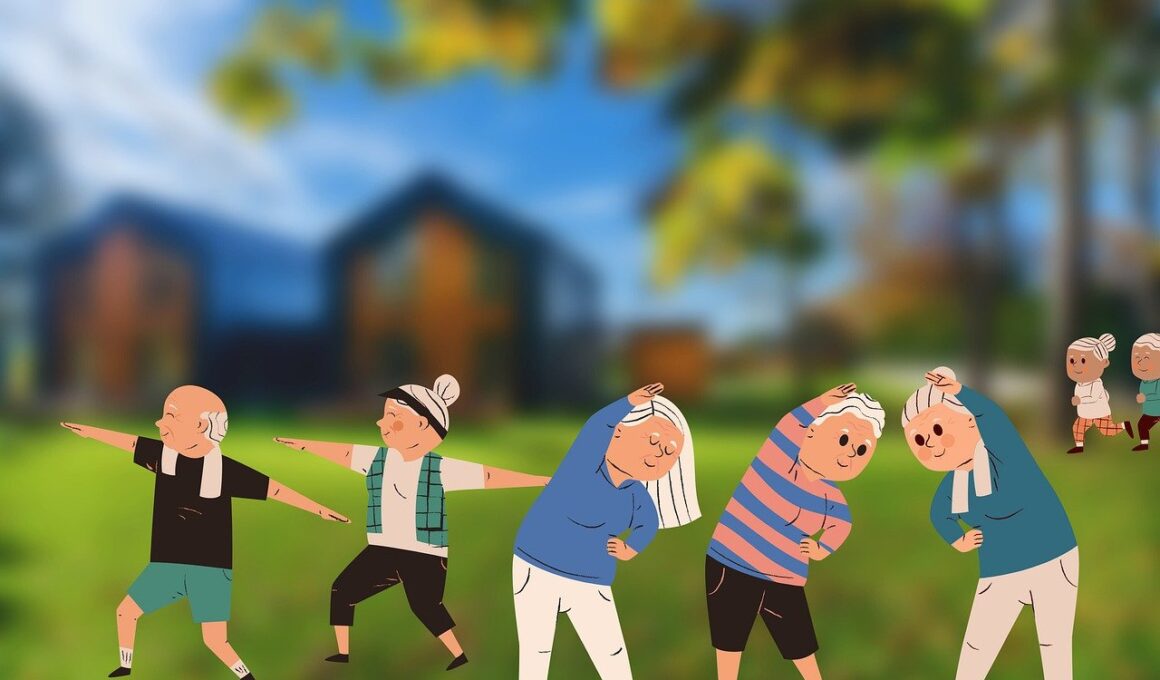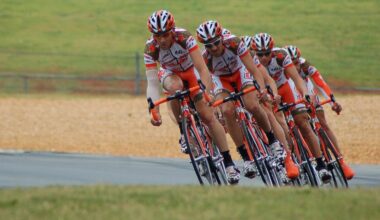Adapting Group Exercises for Seniors with Limited Mobility
Group fitness activities can greatly benefit seniors, especially those with limited mobility. However, customizing these exercises is crucial to ensure safety and effectiveness. Understanding the unique needs of seniors is essential, and it involves recognizing their physical capabilities and any health issues they may have. Modifications in exercises can help prevent injuries while promoting engagement in physical activities. For seniors, focusing on balance, flexibility, and strength exercises can yield significant benefits. Additionally, incorporating items like resistance bands or wall support can enhance stability during workouts. Social interaction is another aspect that contributes to mood and motivation. Group settings provide camaraderie, boosting encouragement and overall enjoyment during workouts. Instructors should consider ways to include all participants, even those with serious limitations. Using chairs or low-impact movements allows everyone to engage without feeling excluded. Moreover, adjusting the pace and intensity of workouts can cater to individual participants. The ultimate goal is to create an inclusive environment where seniors can partake comfortably without feeling overwhelmed. By acknowledging these factors, instructors can facilitate group fitness programs that foster health and happiness among seniors with limited mobility.
Another critical consideration is the proper use of equipment tailored for seniors. Lightweight options, such as dumbbells, resistance bands, or exercise balls, are essential, allowing for movements without excessive strain. Instructors must help seniors to grasp the correct usage of these tools. Demonstrating exercises can enhance understanding and confidence, ensuring participants use them safely. Implementing seated exercises can introduce new participants gradually, making them feel comfortable and capable. This allows them to progress at their own pace, which is crucial for those who may have been inactive for an extended time. Flexibility exercises, for example, can be performed while seated. This adjustment to traditional routines promotes participation among seniors reluctant to join due to mobility issues. Educating participants on the importance of these movements helps highlight benefits such as increased range of motion. Additionally, the routine could include a gentle warm-up followed by cool-down techniques to prevent injuries. Sessions should incorporate a blend of cardiovascular health, strength, and flexibility improvements. Each session could last around thirty minutes, emphasizing consistency over intensity for long-term success.
Creating a Supportive Environment
A supportive and understanding environment enhances the benefits of group fitness for seniors. Group leaders play a vital role in establishing this environment by recognizing and appreciating each participant’s individual journey. It’s essential for instructors to cultivate connections and trust among group members. Encouragement and praise can go a long way in motivating seniors to keep coming back to fitness classes. Additionally, fostering an atmosphere where participants feel respected and valued ensures they are more likely to remain engaged in the program. Tailoring communication styles to suit those with hearing or cognitive limitations can further enhance their experience. Visual aids can be integrated into the session to clarify the movements. Offering alternatives or variations of exercises for participants based on their physical limitations can also help maintain involvement. Developing strong interpersonal relationships among group members encourages sharing experiences, creating a sense of community. Maintaining regular follow-ups on health progress encourages accountability and addresses any concerns seniors may have. Initiating conversations about their achievements, no matter how small, enhances their mental well-being and keeps participants feeling optimistic about their fitness journey.
Another effective strategy for adapting group exercises is emphasizing low-impact activities. Activities such as swimming, chair yoga, or tai chi can be ideal choices, offering gentle movements to improve flexibility and strength. These exercises minimize the risk of injury while promoting cardiovascular fitness. Aquatic exercises allow seniors to experience buoyancy, relieving strain on the joints. Chair yoga brings the advantage of promoting flexibility while ensuring safety, engaging participants who may be less mobile. Instructors can incorporate gentle stretches and breathing practices into each session, which provides relaxation and stress relief. Introducing music during exercise sessions can also enhance motivation and enjoyment. It’s important to select songs that resonate well with seniors, creating a lively atmosphere. Group participation in reminiscing about old songs can create a nostalgic bonding experience. Scheduling classes at convenient times ensures higher attendance rates, as it takes into account the individual schedules of the participants. Furthermore, offering regular workshops focusing specifically on mobility improvements can empower seniors by providing them with new stretches or exercises they can practice outside the group sessions. This encourages self-motivation and health awareness beyond scheduled programs.
Nutrition and Wellness Education
Including nutrition and wellness education as part of group fitness sessions can significantly enrich the overall experience for seniors. This holistic approach can guide seniors in making informed choices that support their fitness goals and overall health. Educators could integrate short discussions on topics like meal planning, hydration, and the importance of balanced diets during sessions. Providing resources such as pamphlets with simple recipes or nutrition tips adds further value. Addressing dietary needs can also help participants understand how specific foods directly impact their physical well-being. For example, emphasizing the inclusion of protein helps with muscle recovery, while calcium and vitamin D promote bone health. Regular hydration is crucial, primarily given that seniors may feel less thirsty and overlook drinking water. Demonstrating the benefits of hydration through interactive methods, such as preparing infused waters, can engage and motivate seniors. Furthermore, encouraging participants to share their favorite healthy recipes nurtures community and makes the program feel inclusive, rather than isolating. Ultimately, merging fitness and nutrition fosters holistic development among seniors, ensuring they benefit from both physical and emotional support in their health journeys.
Introducing specialized workshops focused on mental wellness can further augment fitness programs. These sessions could include mindfulness activities designed to boost cognitive health while offering stress relief. Listening to soothing music, guided visualizations, or simple meditation techniques can be easily integrated into a fitness class setting. Teaching seniors about the connection between mental health and physical activity enhances the relevance of participating in exercises. Providing forums for discussing mental well-being contributes to a supportive environment, adding another layer of connection among participants. Mental wellness discussions can also pave the way for social activities, further cementing bonds within the group. It could involve sharing experiences or discussing common challenges faced by seniors and acting as a support group. Facilitating workshops or guest speakers can introduce various stress management strategies from community resources. Utilizing storytelling within the group encourages openness, allowing seniors to express their experiences and share successes. Furthermore, creating social events that extend beyond workout sessions promotes camaraderie, significantly contributing to community building and enhancing overall connection. Addressing mental wellness acknowledges that a fitness routine impacts all aspects of life for seniors, not just physical health.
Conclusion
In conclusion, adapting group exercises for seniors with limited mobility requires careful consideration to create an inclusive, engaging environment. By focusing on the unique needs of older adults, fitness professionals can develop programs that promote physical and emotional well-being. Incorporating low-impact exercises, appropriate equipment, and modifications fosters participation and safety. Creating a supportive atmosphere ensures that seniors feel valued and motivated to partake in group activities. By educating on nutrition and mental wellness, fitness programs can empower seniors to make healthier lifestyle choices. Importantly, cultivating community among participants creates bonds that encourage regular attendance. Providing opportunities for social interaction, participant sharing, and ongoing support enhances the experience beyond physical fitness. Instructors must remain adaptable and responsive to feedback, ensuring that programs continually meet the needs of all participants. As the demand for senior group fitness programs grows, these tailored approaches will become essential to enhance the quality of life for older adults. It’s crucial to remember that every senior deserves the opportunity to improve their health and well-being, regardless of mobility limitations. By approaching fitness with empathy and creativity, we can unlock extraordinary potential in our senior population.



